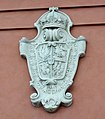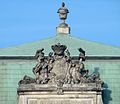Zamek Królewski w Warszawie
History[modifica]
15th century[modifica]
-
Medieval wall of the Curia Maior
-
Original Gothic basement under the castle
-
Wall of the Curia Maior with holes drilled during the WWII
16th century[modifica]
-
Castle in the 16th century
-
Renaissance interior of the Old Chamber of Deputies
-
Renaissance fireplace
17th century[modifica]
Vasa period[modifica]
-
Main facade, 1614-1619
-
Plan of the Royal Castle, 17th century
-
Tsar Vasili IV of Russia and his Brothers before the King Sigismund III in the Senate Chamber at the Castle, 1611
-
Sejm session at the Royal Castle, 1622
-
A Solemn Audience before the Sigismund III in the Senate Chamber at the Castle, 1630
-
Sigismund III on his deathbed in the Guard Chamber at the Castle, 1633
-
Sigismund III on his deathbed in the Guard Chamber at the Castle, 1633
-
Opera Hall at the Royal Castle, built in 1637
-
View form Vistula River, 1627
-
View form Vistula River, 1641
-
View form Vistula River, 1656
-
Tapestry with the coat of arms of Anna Catherine Constance Vasa, Warsaw Royal Castle manufacture, ca. 1642
-
Orchestra of Władysław IV Vasa, 1649
Marble Room[modifica]
The Marble Room was adorned with the so-called Jagiellon Family, a collection of 22 octagonal effigies, painted by Peeter Danckers de Rij between 1640-1643.
-
Design by Giovanni Battista Gisleni
-
Portrait of Sigismund Augustus
-
Portrait of John III Vasa
-
Portrait of Cecilia Renata of Austria
Furnishings[modifica]
Majority of the preserved castle furnishings from the Vasa period found its place in the collection of the Visitationist Monastery in Warsaw as donations of the last Vasa, John II Casimir and his wife Marie Louise Gonzaga.
-
Ebony cabinet, David Altenstetter
-
Portrait of Maria Anna of Spain, Frans Luycx
-
Portrait of Anne of Austria, Justus van Egmont
-
Our Lady in a garland of roses, Il Sassoferrato
Prince-Bishop Vasa's Palace[modifica]
-
The Palace was constructed in 1643 on the northern bastion of the Royal Castle's curtain wall
-
The Palace covered with characteristic pyramidal roof as seen in 1656
-
Cartouche with coat of arms of Charles Ferdinand Vasa, that once adorned the Palace
Sobieski period[modifica]
-
Royal Castle in Warsaw during the reign of John Sobieski
-
Castle Square and Sigismund Column, 1690-1698
-
The New Chamber of Deputies at the Royal Castle in the end of the 17th century
-
Jan III Sobieski's Bath, built in 1681
18th century[modifica]
Saxon period[modifica]
-
Reconstruction design, c. 1700
-
New Senate Chamber, 1720
-
Saint John's Gate, 1720s
-
Eastern wing of the Royal Castle, 1740/41
Stanisław Augustus period[modifica]
-
Reconstruction design of the Castle by Jakub Fontana
-
Reconstruction design of the Senate Chamber by Victor Louis
-
View of Warsaw from the terrace of the Royal Castle by Bernardo Bellotto, 1773
-
The Constitution of May 3, 1791, is adopted by the "Great" or Four-Year Sejm of 1788–92 at the Senate Chamber
19th century[modifica]
-
The Castle in 1830, xylograph depicting the early stages of the November Uprising in Warsaw
-
The Castle in 1860
-
Russian army in Warsaw 1861 during martial law
-
Throne of Stanisław Augustus Poniatowski displayed in the Moscow Kremlin
-
Conference Room at the Castle without paintings (looted by the Russians)
20th century[modifica]
-
Castle Square, ca 1910
-
Kierbedz Bridge and the riverside view of the Castle
-
Polish airship "Lech" over Royal Castle.
-
Aerial view of the Castle in the 1920s
Destruction[modifica]
On September 17, 1939 (date of the Soviet invasion of Poland) the Castle was shelled by German artillery. In 1944, after the collapse of the Warsaw Uprising, the Germans blew up the Castle’s demolished walls.
September 17, 1939[modifica]
1940-1944[modifica]
1945[modifica]
Today[modifica]
Reconstruction[modifica]
-
Conception of reconstruction, 1971
-
Building under construction and without plaster, 1975
Exterior[modifica]
Overview[modifica]
-
Sigismund's Column and the Castle
-
Main facade
-
Southern facade
-
Escarpment
Sigismund's Tower[modifica]
-
Front view
-
Side view
-
Vasa cartouche
Courtyard and Władysław's Tower[modifica]
-
Royal House (left) and Curia Maior (right)
-
Władysław's Tower
-
Early baroque portal with cartouche
Eastern facade[modifica]
-
Front view
-
Central limb
-
Wettin cartouche
Kubicki Arcades[modifica]
-
Arcades
-
Stairs
-
Interior
Copper-Roof Palace[modifica]
-
Corps de logis
-
Cour d'honneur
-
Left wing and the Royal Library
-
Back facade
-
Poniatowski bedroom
Interior[modifica]
-
The Old Chamber of Deputies
-
National Hall
-
Great Assembly Hall
-
Council Chamber
-
Marble Room
-
Yellow Room
-
Canaletto Room
-
Throne Room
-
Royal Chapel
-
The King's bedchamber
Collections[modifica]
| Collections of ZKW | ||
|---|---|---|
Wartime losses[modifica]
-
Breakfast, Jan Davidsz. de Heem
-
So-called Wilanów Carpet, Kashan
-
Warsaw Castle after a fire, Bernardo Bellotto
-
Console table with rotary clock, after Jean-Louis Prieur
Painting[modifica]
-
Madonna and Child, Coppo di Marcovaldo
-
Saint John the Baptist, Joos van Cleve
-
Adam and Eve, Lucas Cranach
-
Portrait of a redhead girl, Prospero Fontana
-
Portrait of Sigismund III Vasa, Jakob Troschel
-
Art Collection of Prince Władysław Vasa, Étienne de La Hire
-
Portrait of Charles I of England, Anthony van Dyck
-
Trompe l'oeil with violin, Cornelis Norbertus Gijsbrechts
-
Still-life with the hunting trophy, Melchior d'Hondecoeter
-
Portrait of Pope Pius VI, Pompeo Batoni
-
Portrait of Pélagie Sapieżyna, Elisabeth Vigée-Lebrun
-
Portrait of George III of the United Kingdom, Thomas Gainsborough
Lanckoroński Collection[modifica]
-
Portrait of Antoine de Bourbon, Corneille de Lyon
-
The Girl in a Picture Frame, Rembrandt Harmenszoon van Rijn
-
The Scholar at the Lectern, Rembrandt Harmenszoon van Rijn
-
The Smoker and the Drunkard, Adriaen van Ostade
-
The Rzewuski Brothers with Roman Buildings in the Background, Anton von Maron
Paintings in the Canaletto Room[modifica]
-
View of Warsaw
-
Cracow Suburb Street
-
Cracow Suburb Street
-
Cracow Suburb Street
-
Iron Gate Square
-
Długa Street
-
Miodowa Street
-
Carmelite Church
-
Visitationist Church
-
Bridgettine Church and Arsenal
-
New Town Market Square
-
Mniszech Palace
-
Blue Palace
-
Wilanów Palace
-
Wilanów Palace as seen from north-east
Paintings in the Great Antechamber[modifica]
-
Caesar's remorse at the death of Pompey, Louis-Jean-François Lagrenée
-
The Continence of Scipio, Joseph-Marie Vien
-
Scilurus, King of Scythia begging his sons to reconcile, Noël Hallé
-
Caesar before the statue of Alexander, Joseph-Marie Vien
Stockholm Roll[modifica]
Entry of the Wedding Procession of Constance of Austria and Sigismund III into Cracow, so-called Stockholm Roll, 1605.
Sculpture[modifica]
-
Resting Satyr, After Praxiteles
-
Cosimo I de' Medici, Giovanni Caccini
-
John III Sobieski as Roman Emperor, Pierre Vanneau
-
Giovanni Battista Cambiaso, Pasquale Bocciardo
-
Marsyas, André Le Brun
Textiles[modifica]
-
Moral fall of humanity, Jan de Kempeneer
-
Pelmet of a canopy of Ladislaus Vasa, Poland
-
"Dragon" carpet, Caucasus
-
Chancellerie tapestry, Manufacture des Gobelins
-
Rug with a Basket, Tulczyn Manufacture























































































































































